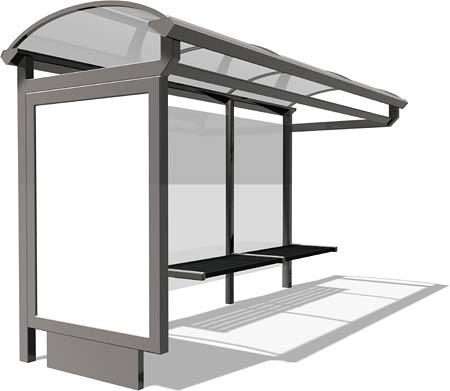An adshel is a poster that is integrated into the structure of a bus shelter. These posters are usually backlit. The term ‘Adshel’ is proprietary but it is often used as a generic term for the posters that are displayed on a wall of the shelter of a bus stop. There are advertising companies that focus solely on creating designs for this type of product. A common mistake is to write adshell with a double ‘l’.
In Dutch, French and German this type of product is called an abribus. This is also a proprietary term that over time has become a generic description.
Another term for these posters is City-Light-Poster or CLP Poster.
Guidelines for creating and producing adshel or abribus posters
These posters have some pretty specific requirements, some of which affect the design while others are purely production related. In case of doubt contact the printer who will print the posters.
Design requirements
- The outer borders of the poster are hidden within the frame in which it is mounted. This causes the visible area to be a few centimeters smaller. Because of possible inaccuracies when the poster gets mounted, there is a fairly wide border around the visible area in which you cannot place any text or critical artwork. This is called the safety zone. Any text or logos in that zone might not be visible when the poster is mounted.
- Posters of this size usually don’t need very high resolution images because of the viewing distance. That is only partially true for these posters since they can be viewed from pretty close by. A resolution of 100 ppi seems to be acceptable.
- The printing process may not be capable of reproducing tints below 3% or above 97%. This must be taken into account for the images.
- As with many types of posters designers are often expected to deliver files that are scaled. The InDesign or QuarkXPress design is typically done on a scale of 1:4 (versus the 1:10 ratio which is often used for billboards).
Production requirements
- Posters that are backlit are printed on both sided. The back side is the mirror image of the front side (reverse printing). This is done to deepen the colors and to prevent the lighting tubes from shining through.
- Often only C, M and Y get printed on the back.
- The reverse printing obviously requires both sides to have pretty good registration.
- To make sure the light still gets through, the back side is done using a tint reduction – a 100% color on the front might be reduced to a 30% tint on the back side.
- To avoid issues with moire, the visible side is printed with a conventional raster while the back side is done using stochastic screening.
- The screening on the visible side is still a fairly coarse screen, such as 60 lpi.
 Stock photography agencies have images such as the above available to create a visual of the proposed poster.
Stock photography agencies have images such as the above available to create a visual of the proposed poster.